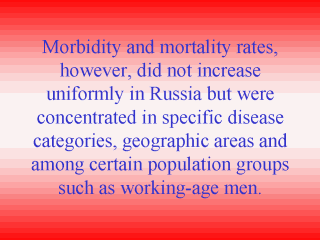 |
A substantial
gender gap of increased mortality among men was evident in the cause-specific death rates
for each year from 1970 to 1995. After an increase in life-expectancy in 1985-1987 of 3
years in men and 1.5 years in women, male life expectancy in Russia decreased by 1.1 years
between 1987-1991, and by 6 years in 1992-1994. Women's life expectancy was stable in 1987
and decreased by 3.2 years in 1992-1994. There was a 45% increase in the absolute number
of deaths per annum between 1989-1994; 79% of this increase in the absolute number of
deaths is attributable to excess deaths and 21% to the natural aging of the population.
Working-age mortality also increased for men, 25-44 years, and women, 15-44 years, in the
1990's. As compared to 1987, the age-specific death rates among Russian men increased by
1.3 in 1991 to 2.0 in 1993 and 2.5 in 1994. The comparable increases for Russian women, as
compared to 1987 age-specific death rates, is 1.2 in 1991 to 1.7 in 1993 and 2.0 in 1994.
The working-age death rate among men may be summarized as a 54% mortality increase among
the 15-44 year old and a 40% increase among those 45-64 years old in 1991-1992; and 41%,
42% in 1992-1993, respectively, and 34% and 53% in 1993-1994, respectively. Rates for
women showed a similar pattern for the periods cited, but at a smaller rate of increase
(Shkolnikov, 1995). |
